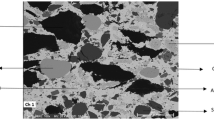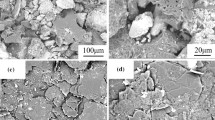Abstract
In order to investigate the running-in process of a dry friction pair made of Cu-based powder metallurgy material and 65Mn steel, well designed pin-on-disc tests are carried out. According to the running-in mechanism of Cu-based powder metallurgy material in the tests, the running-in process is divided into two periods, namely, the interface matching period and the plastic deformation period. Then, two division indexes (the average height Sa and the root mean square height Sq) are introduced as basis for dividing this two periods, which originate from the extraction and analysis of surface morphology of asperities on the contacting surface. In the same way, two running-in recognition indexes, including equivalent changing rate H and coefficient of variation D, are further put forward as measures to characterize the running-in progress, and their effectiveness is verified by tests. Based on the recognition indexes H and D, the influence of temperature, rotation speed and load on the running-in duration of the dry friction pair is studied, and the efficient condition of running-in process is obtained. The results show that, when H ≤ 1.9 × 10−3 and D ≤ 4.2 × 10−2, we can recognise that the running-in process is completed. The running-in duration is almost the shortest under the condition of (40 N, 1400 r/min, 160 °C), which is called the efficient running-in condition.











Similar content being viewed by others
References
Archard JF (1953) Contact and rubbing of flat surfaces[J]. J Appl Phys 24(8):981–988
Archard JF (1961) Single contacts and multiple encounters[J]. J Appl Phys 32(8):1420–1425
Archard JF (1957) Elastic deformation and the laws of friction[J]. Proceedings of the Royal Society a Mathematical Physical & Engineering. Sciences 243(1233):190–205
Majumdar A, Bhushan B (1991) Fractal model of elastic-plastic contact between rough surfaces[J]. J Tribol 113(1):1–11
Bhushan B (1998) Contact mechanics of rough surfaces in tribology: multiple asperity contact[J]. Tribol Lett 4(1):1–35
Chatterjee B, Sahoo P (2013) Finite element based parametric study of elastic-plastic contact of Fractal surfaces [J]. Procedia Eng 64:552–561
Ge S, Chen G (1999) Characterization of surface topography changes during running-in process with characteristic roughness parameter[J]. J Xuzhou Inst Techno
Zhu H, Jiang W, Cui-Cui JI (2008) Change law of Fractal dimension of Wear surface during running-in process[J]. J Xuzhou Inst Techno
Jiang W, Zhu H, Cui-Cui JI et al (2008) Test of running-in process and Fractal characterization of change rule of surface topography[J]. J Shandong Univ Sci Technol
Wei L, Chang XZ, Zhang PG (2011) Fractal Characterization of changing of surface topography of the end face of soft ring in running-in procedure for mechanical seal[J]. China Surf Eng 24(5):78–82
Yeauren J, Chihchung G (2000) Changes of surface topography during Wear for surfaces with different height distributions[J]. ASLE T 43(4):749–757
Jeng YR (2000) Topographical changes of engine bores during engine running in[J]. SAE Tech Pap
Jeng YR, Lin ZW, Shyu SH (2004) Changes of surface topography during running-in process[J]. J Tribol 126(3):620–625
Zhang G, Liu X, Lu W (2013) A parameter prediction model of running-in based on surface topography[J]. P I MECH ENG J-J ENG 227(9):1047–1055
Zhang GP, Liu XJ, Lu WL (2013) Surface topography characterization in steel running-in process of dry sliding friction[J]. Appl Mech Mater 278-280:414–417
Clarke A, Weeks IJJ, Snidle RW et al (2016) Running-in and micropitting behaviour of steel surfaces under mixed lubrication conditions [J]. Tribol Int 101:59–68
Cristino VAM, Rosa PAR, Martins PAF (2015) The role of interfaces in the evaluation of friction by ring compression testing[J]. Exp Tech 39(4)
Boudoukha H, Djabi S, Coquillet B (2010) Tribological characterization of heat-resisting steel [J]. Exp Tech 34(3)
Wittenberghe JV, Ost W, Baets PD (2012) Testing the friction characteristics of industrial drum brake linings[J]. Exp Tech 36(1):43–49
Kovalchenko AM, Fushchich OI, Danyluk S (2012) The tribological properties and mechanism of wear of cu-based sintered powder materials containing molybdenum disulfide and molybdenum diselenite under unlubricated sliding against copper[J]. Wear 290-291(7):106–123
Fan J, Zhang C, Wu S et al (2017) Effect of Cr–Fe on friction and wear properties of cu-based friction material[J]. Mater Sci Technol:1–7
Fu R, Gao F, Song BY (2010) Study on friction properties of cu-Fe-based powder metallurgy materials under dry and wet friction conditions[J]. Adv Mater Res 150-151:1806–1809
Fei J, Li HJ, Fu YW et al (2010) Effect of phenolic resin content on performance of carbon fiber reinforced paper-based friction material[J]. Wear 269(7):534–540
Ompusunggu AP, Sas P, Van Brussel H (2015) Distinguishing the effects of adhesive wear and thermal degradation on the tribological characteristics of paper-based friction materials under dry environment: a theoretical study[J]. Tribol Int 84:9–21
Yingzhi L, Chen G (2005) Study on surface topography during gears running-in[J]. MACH Development
Pawlus P (1997) Change of cylinder surface topography in the initial stage of engine life[J]. Wear 209(1–2):69–83
Mezghani S, Demirci I, Yousfi M et al (2013) Running-in wear modeling of honed surface for combustion engine cylinderliners[J]. Wear 302(1–2):1360–1369
Yousfi M, Mezghani S, Demirci I et al (2015) Smoothness and plateauness contributions to the running-in friction and wear of stratified helical slide and plateau honed cylinder liners[J]. Wear 332–333:1238–1247
Karpinska A (2010) Running-in and the evolution of metallic surfaces subjected to sliding and rolling contact[D]. Imperial College, London
Liang D, Yao Z, Dong G et al (2012) Study on wear monitoring of running in period using online image visual ferrography[J]. Eq Manage Maintenance (11):53–55 (in Chinese)
Acknowledgements
This research was partly supported by the Natural Science Foundation of China (Grants No. 51575042 and 51775045) and by the International Graduate Exchange Program of Beijing Institute of Technology.
Funding
The Natural Science Foundation of China (No.51575042 and No.51775045).
Author information
Authors and Affiliations
Corresponding author
Ethics declarations
Conflict of Interest
No conflict of interest exits in the submission of this manuscript, and the manuscript is approved by all authors for publication.
Additional information
Publisher’s Note
Springer Nature remains neutral with regard to jurisdictional claims in published maps and institutional affiliations.
Rights and permissions
About this article
Cite this article
Wu, J., Ma, B., Li, H. et al. The Running-in Micro-Mechanism and Efficient Work Conditions of Cu-Based Friction Material against 65Mn Steel. Exp Tech 43, 667–676 (2019). https://doi.org/10.1007/s40799-019-00323-1
Received:
Accepted:
Published:
Issue Date:
DOI: https://doi.org/10.1007/s40799-019-00323-1




